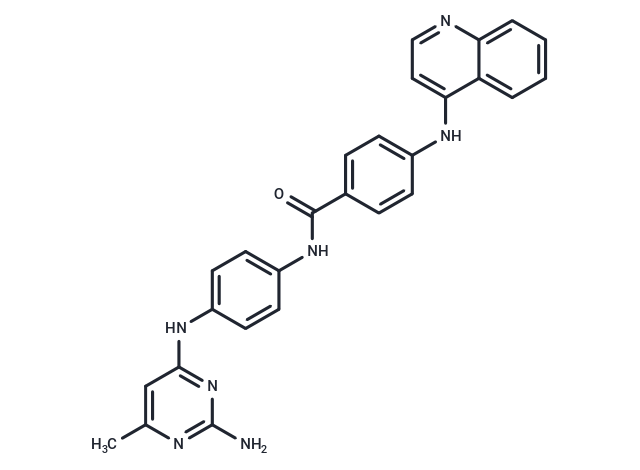Shopping Cart
- Remove All
 Your shopping cart is currently empty
Your shopping cart is currently empty

SGI-1027 (DNA Methyltransferase Inhibitor II) is an effective and selective inhibitor of DNA methyltransferase (DNMT). The IC50 of SGI-1027(SGI1027) against DNMT1, DNMT3A, and DNMT3B are 6, 8, 7.5 μM, respectively.

| Pack Size | Price | Availability | Quantity |
|---|---|---|---|
| 5 mg | $53 | In Stock | |
| 10 mg | $95 | In Stock | |
| 25 mg | $166 | In Stock | |
| 50 mg | $312 | In Stock | |
| 100 mg | $492 | In Stock | |
| 500 mg | $1,090 | In Stock | |
| 1 mL x 10 mM (in DMSO) | $68 | In Stock |
| Description | SGI-1027 (DNA Methyltransferase Inhibitor II) is an effective and selective inhibitor of DNA methyltransferase (DNMT). The IC50 of SGI-1027(SGI1027) against DNMT1, DNMT3A, and DNMT3B are 6, 8, 7.5 μM, respectively. |
| Targets&IC50 | DNMT3B:7.5 μM, DNMT3A:8 μM, DNMT1:6 μM |
| In vivo | SGI-1027, at concentrations ranging from 0 to 100 μM, demonstrates moderate pro-apoptotic effects in the U937 human leukemia cell line without affecting the cell cycle. It directly inhibits DNMTs, leading to suppression of DNA methylation and selective degradation of DNMT1 across various human cancer cell lines. In the rat hepatoma H4IIE cells, SGI-1027 exhibits minimal or no toxicity. |
| Kinase Assay | DNA methyltransferase (CpG methyltransferase) assay: DNA methylase activity is assayed by measuring the incorporation of 3H1-methyl group from Ado-Met into DNA using DE-81 ion exchange filter binding assay with some modifications. Human recombinant DNMT1, recombinant mouse Dnmt3a/ Dnmt3b (500 ng) is incubated with 500 ng of poly(dI-dC) or hemimethylated DNA duplex and 75 or 150 nM (0.275μCi or 0.55μCi) of [methyl-3H]-Sadenosylmethionine (Ado-Met) in a total volume of 50 μl at 37°C for 1hr. or M. Sss I is assayed in the supplier's buffer. SGI-1027 or decitabine is added at indicated concentrations. Each reaction is performed in duplicate and included controls with no inhibitor or no DNA. The reaction is stopped by soaking reaction mixture onto a Whatman DE-81 ion exchange filter disc, washed (five times, 10 min each, with 0.5M Na-phosphate buffer; pH 7.0) dried and counted in a scintillation counter. The background radioactivity (no DNA control) is subtracted from the values obtained with reaction mixtures containing DNA and the radioactivity obtained in the reaction without any inhibitor is considered as 100% activity. IC50 is determined by interpolation from the plot of percent activity versus inhibitor concentration. To determine the nature of inhibition of DNMTase activity by SGI-1027, DNMT1 enzyme activityis measured in presence of a fixed concentration of inhibitor (0, 2.5, 5, and 10 μM) while one of the two (Ado-Met or DNA) was varied in a particular reaction mixture. At a fixed concentration of DNA (500 ng) varying concentrations of Ado-Met used are from 25-500 nM, respectively. Similarly, final DNA concentrations are varied from (25-500ng) at 75 nM Ado-Met. |
| Cell Research | Rat hepatoma H4IIE cells are used as the test system. These cells are grown in DMEM supplemented with fetal bovine serum (10%) and calf serum (10%). Cells are seeded into 96-well plates and after 48 h exposed to SGI-1027 at concentrations ranging from 0 to 300 μMol/L. The solubility is determined by Nephalometry techniques immediately after dosing and before harvesting the cells at 24 h. Following the exposure period, the cells or their supernatant (culture medium) are analyzed for changes in cell proliferation (propidium iodide), membrane leakage (α-GST), mitochondrial function [3-(4,5-dimethylthiazol-2-yl)-2,5-diphenyltetrazolium bromide and cellular ATP], oxidative stress (intracellular GSH and 8-isoprostane), and apoptosis. The half-maximal toxic concentration (TC50) is determined from the dose-response curves.(Only for Reference) |
| Alias | SGI1027, DNA Methyltransferase Inhibitor II |
| Molecular Weight | 461.52 |
| Formula | C27H23N7O |
| Cas No. | 1020149-73-8 |
| Smiles | Cc1cc(Nc2ccc(NC(=O)c3ccc(Nc4ccnc5ccccc45)cc3)cc2)nc(N)n1 |
| Relative Density. | 1.387 g/cm3 (Predicted) |
| Storage | Powder: -20°C for 3 years | In solvent: -80°C for 1 year | Shipping with blue ice. | ||||||||||||||||||||||||||||||
| Solubility Information | DMSO: 45 mg/mL (97.5 mM), Sonication is recommended. | ||||||||||||||||||||||||||||||
Solution Preparation Table | |||||||||||||||||||||||||||||||
DMSO
| |||||||||||||||||||||||||||||||

Copyright © 2015-2025 TargetMol Chemicals Inc. All Rights Reserved.